
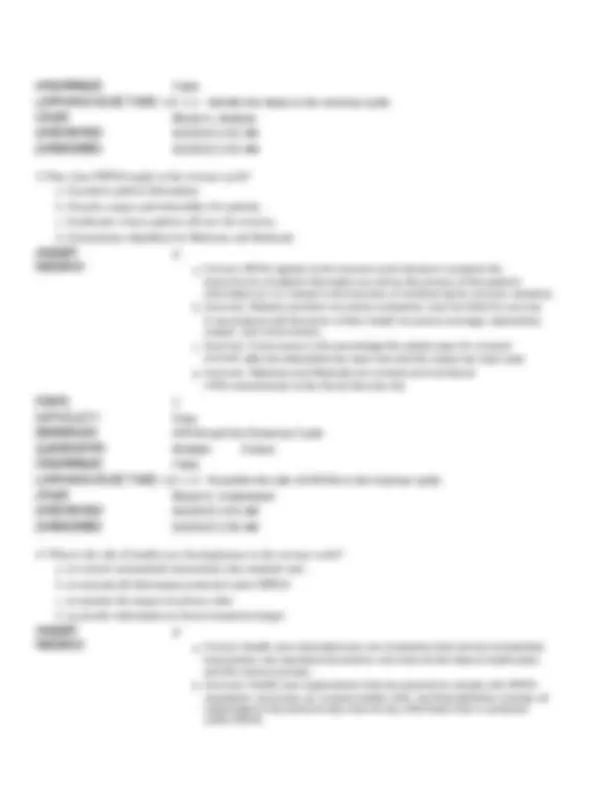
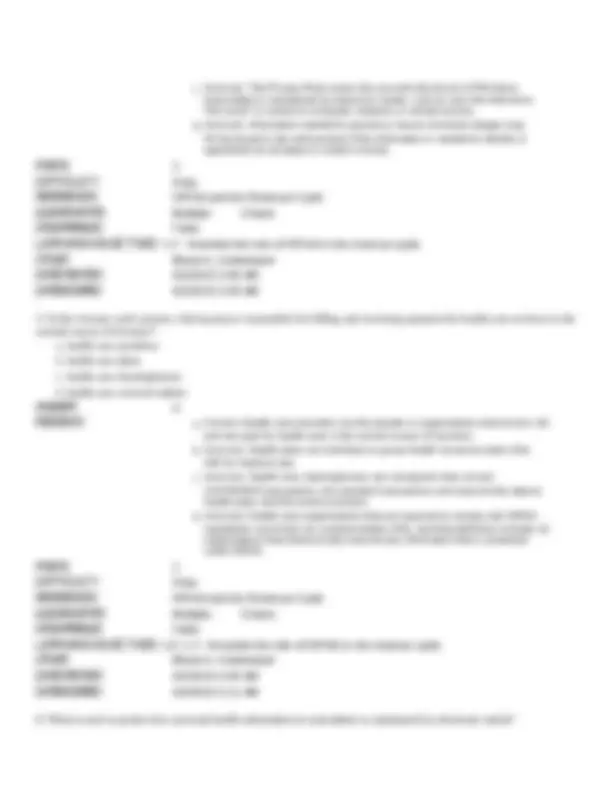
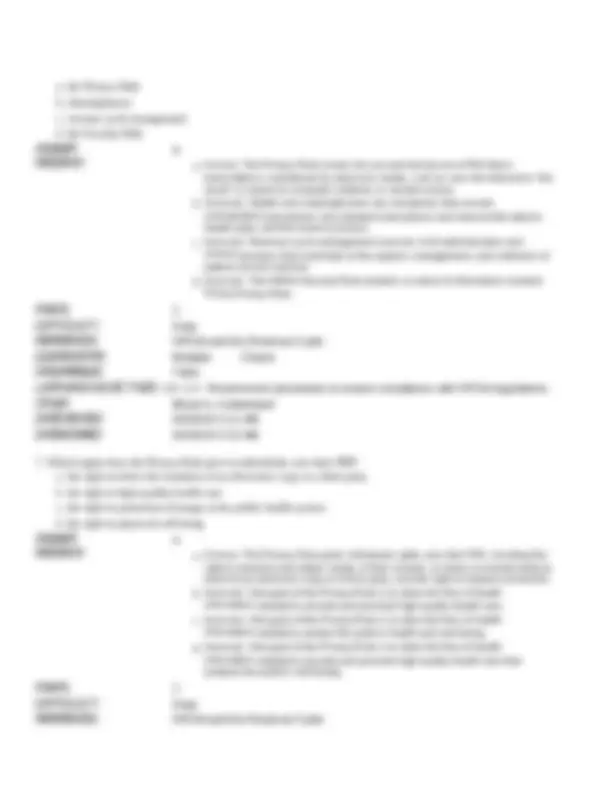
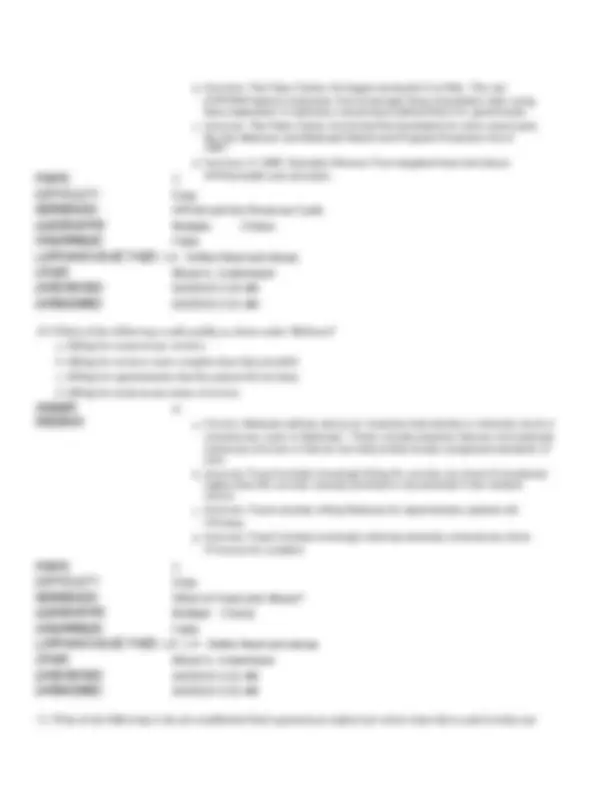

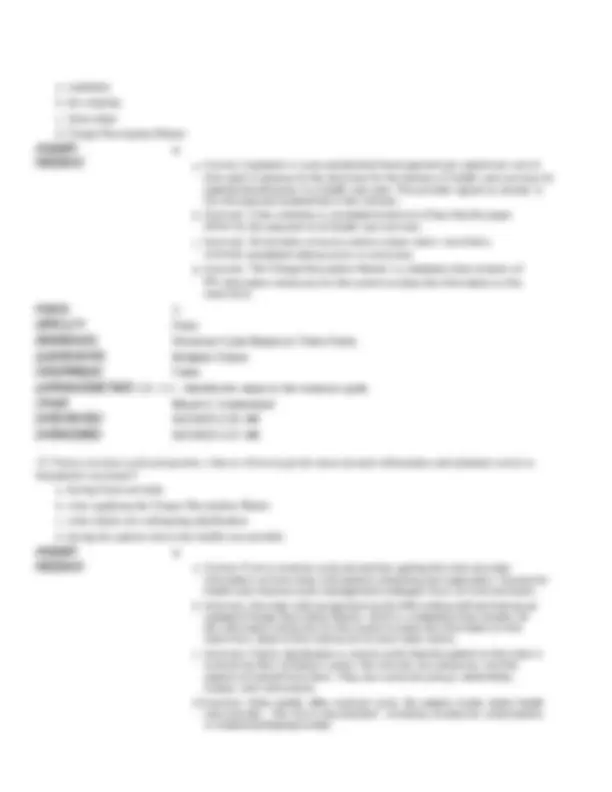

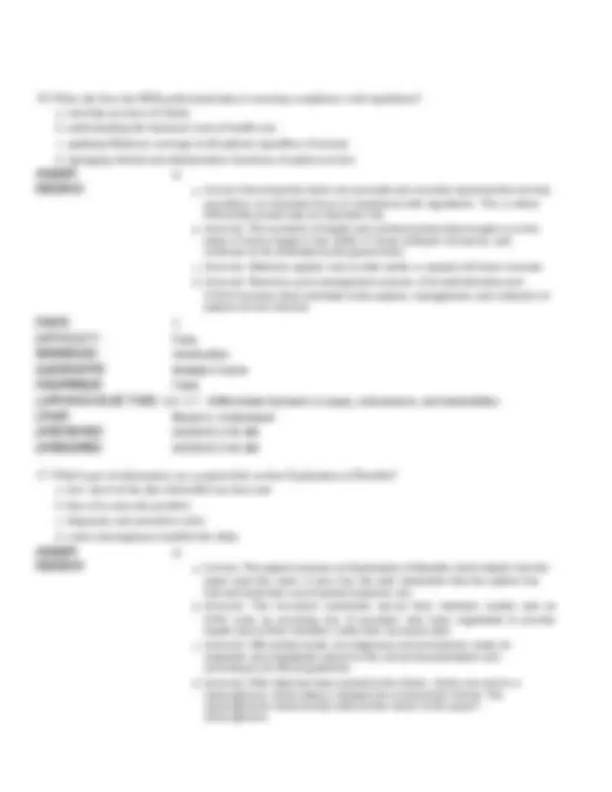

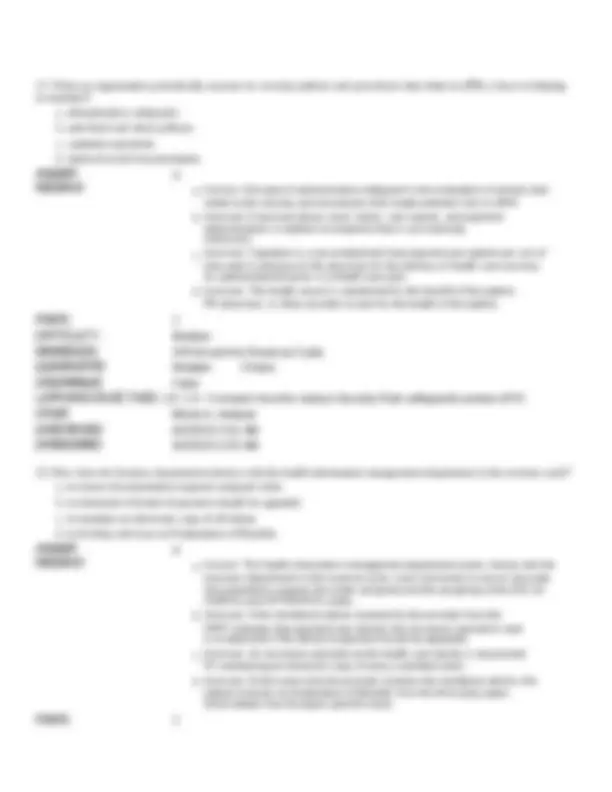

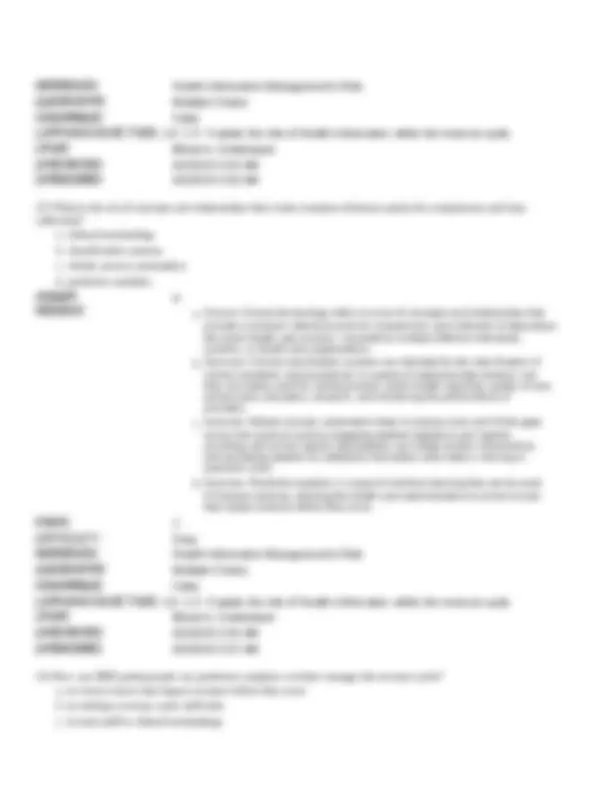

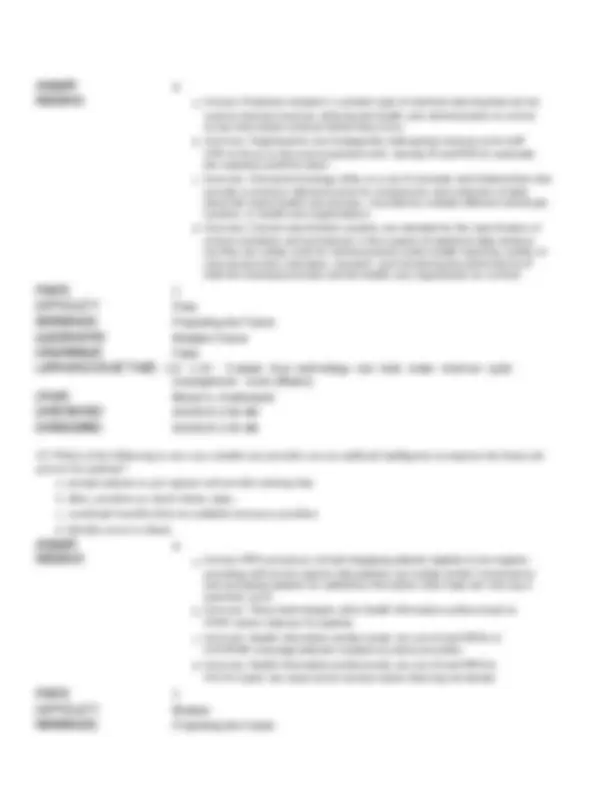
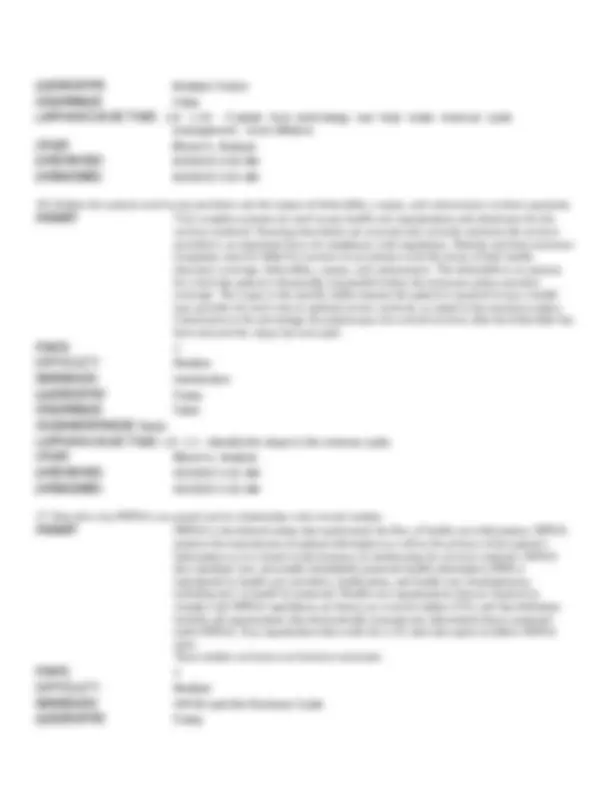

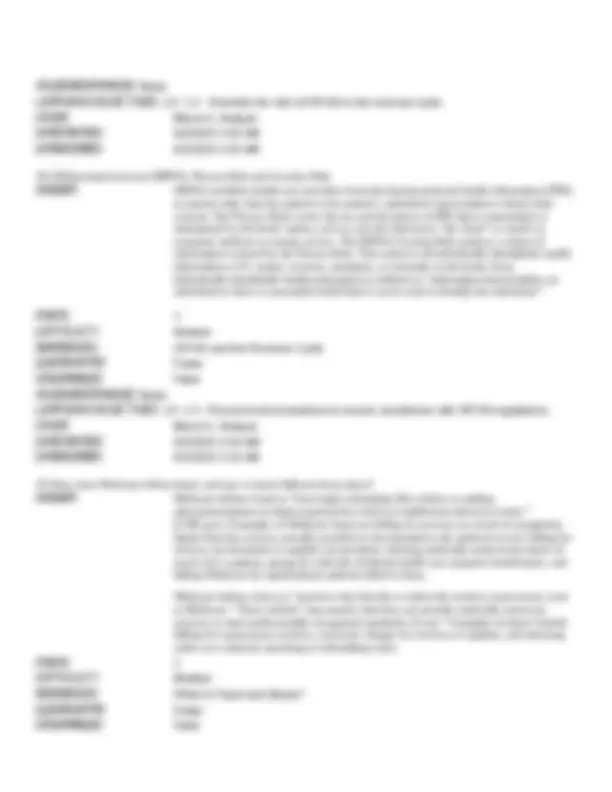
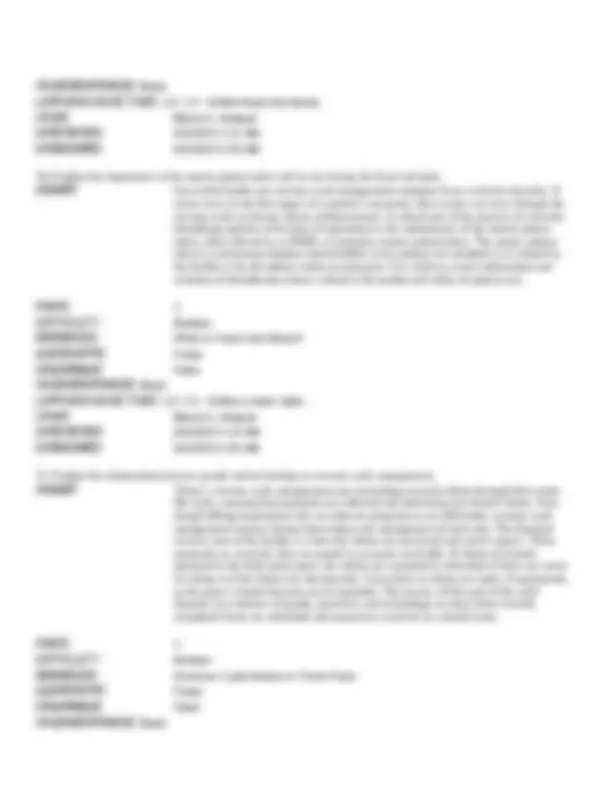
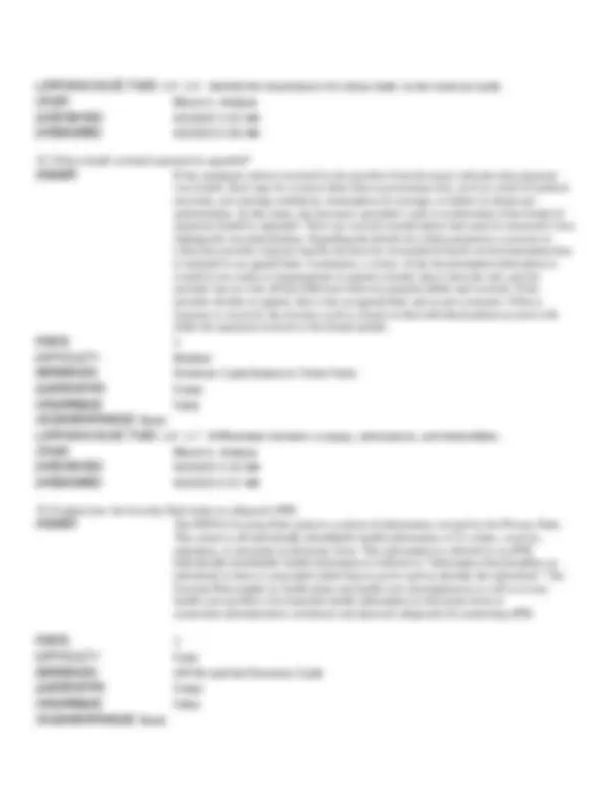
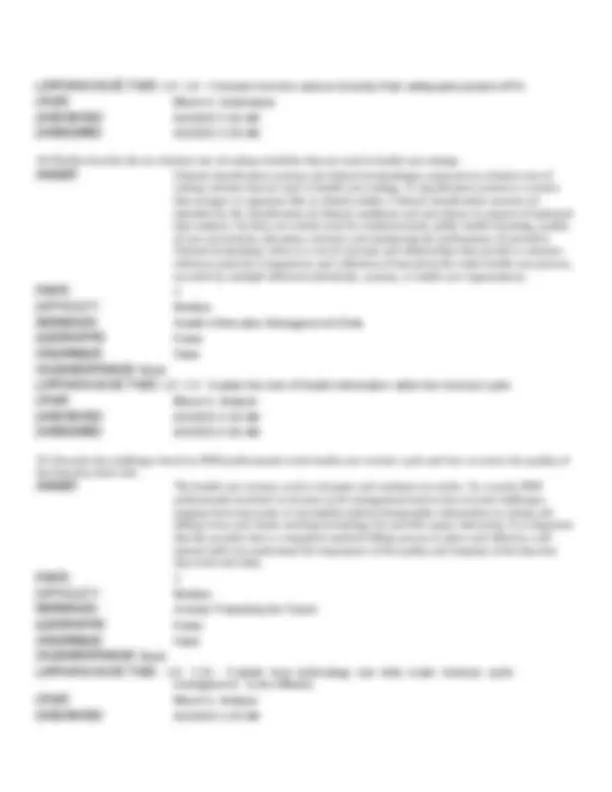

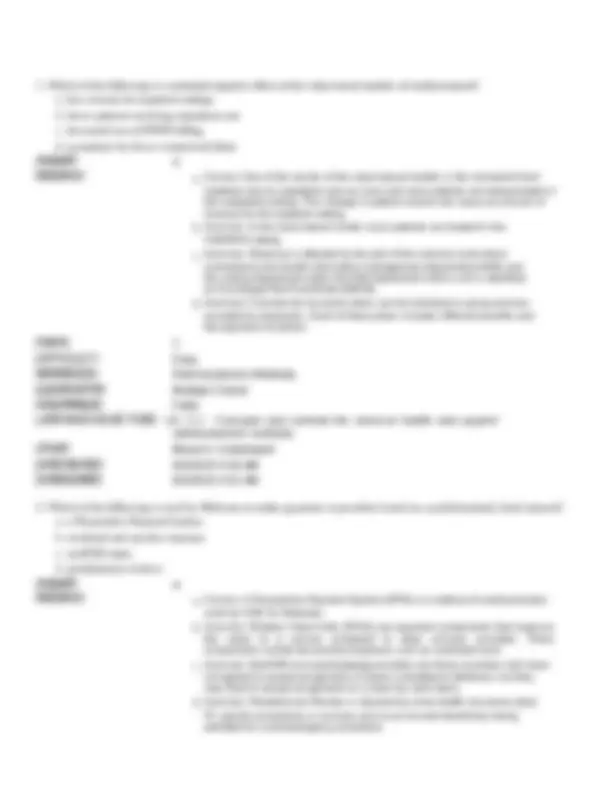
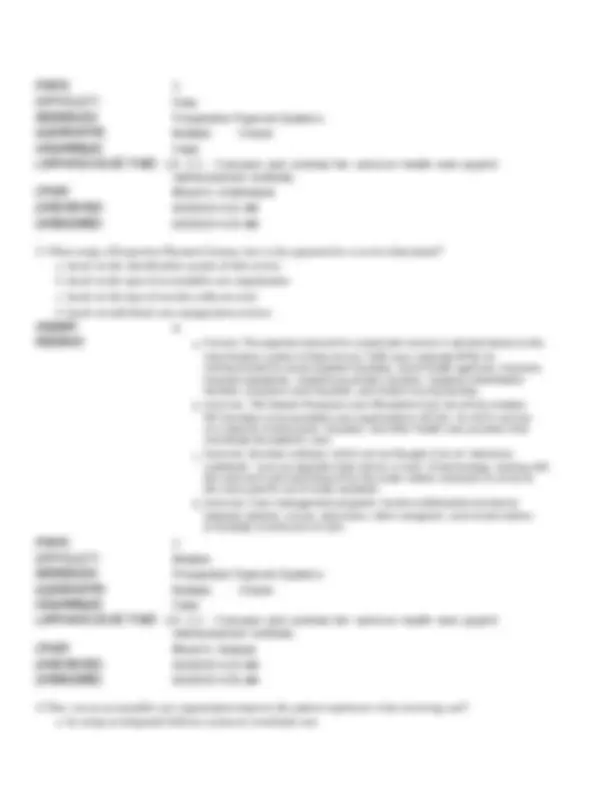
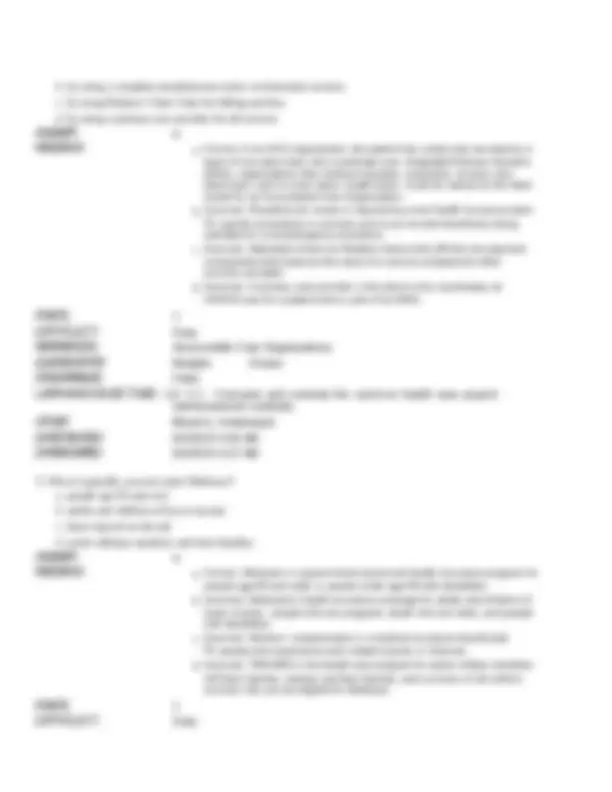
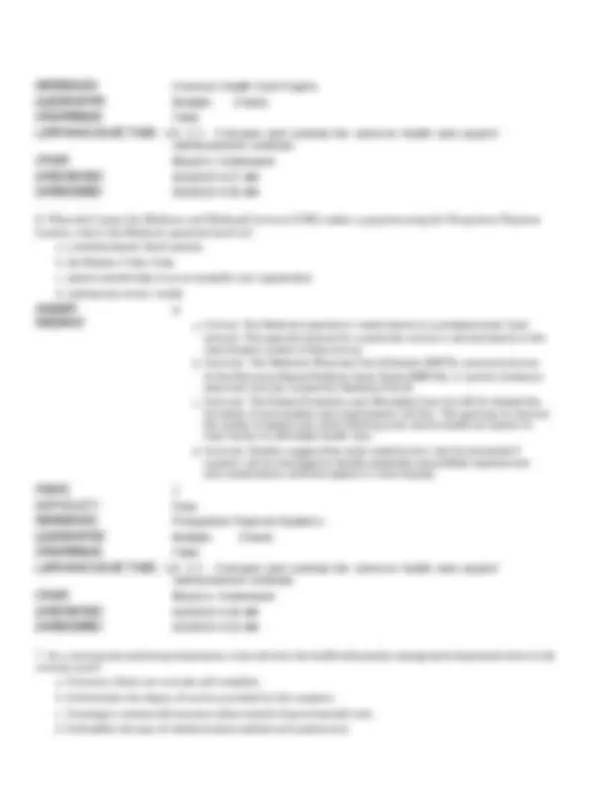
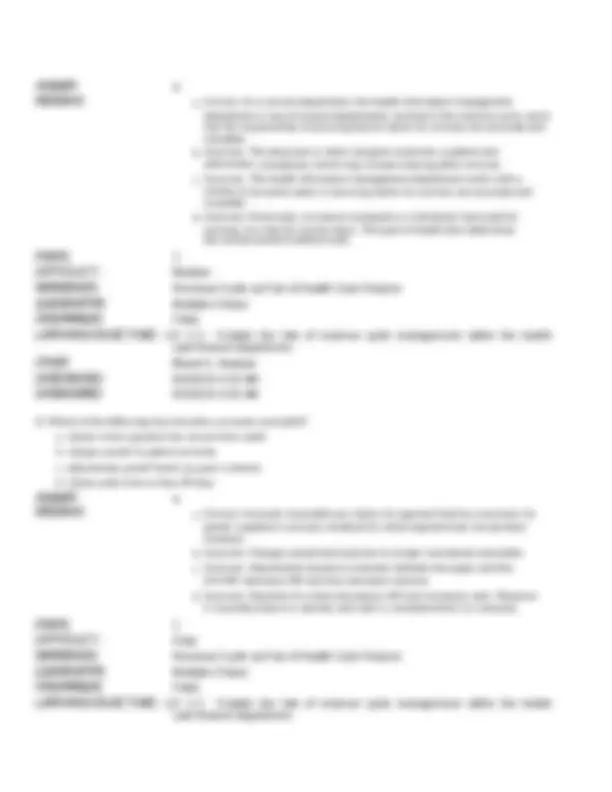

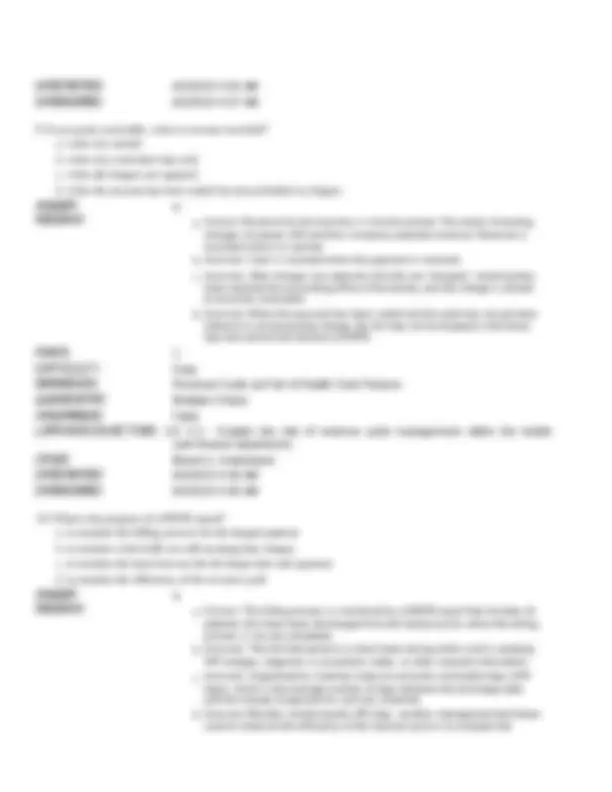

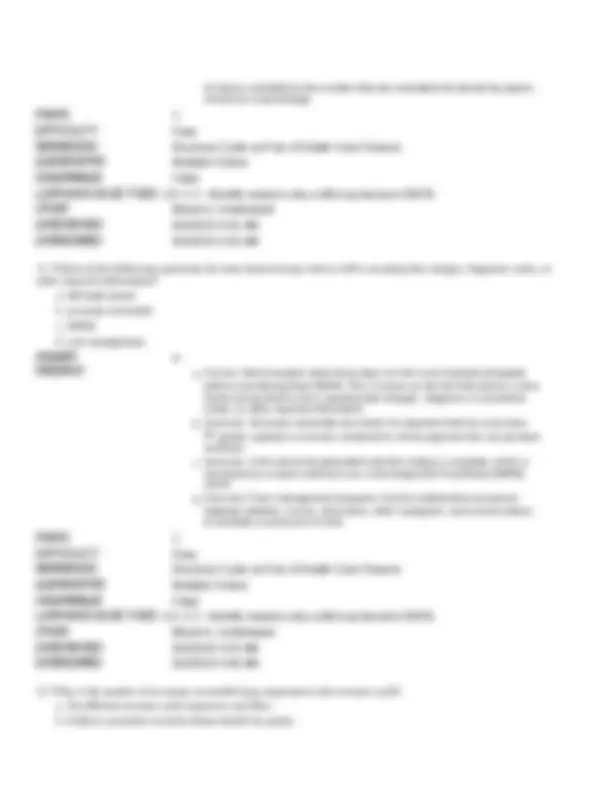

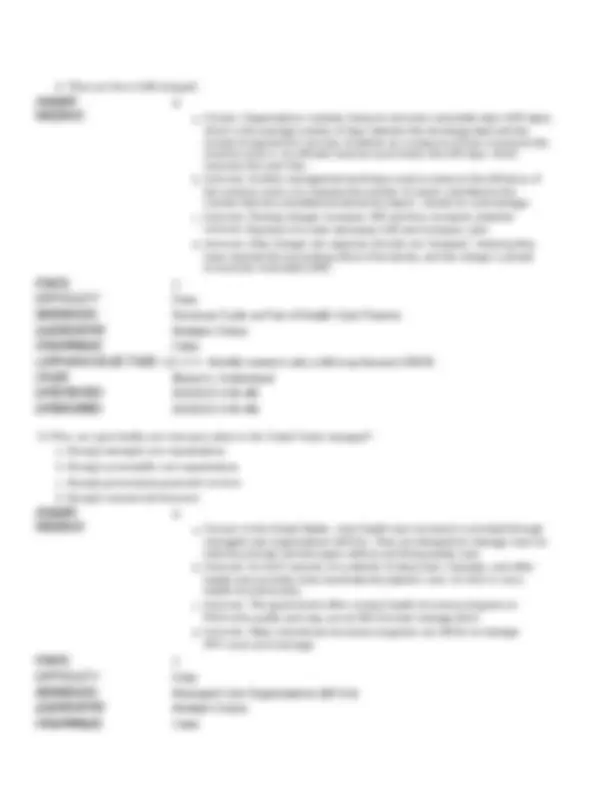
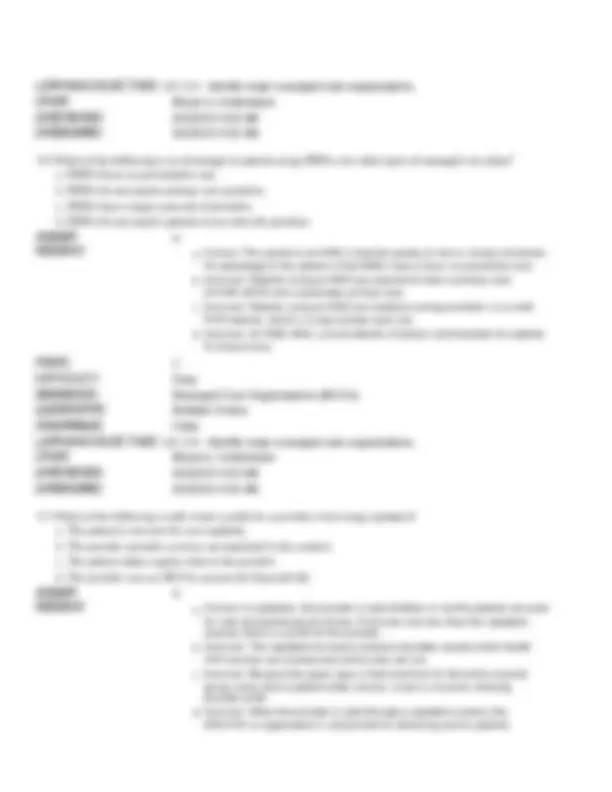

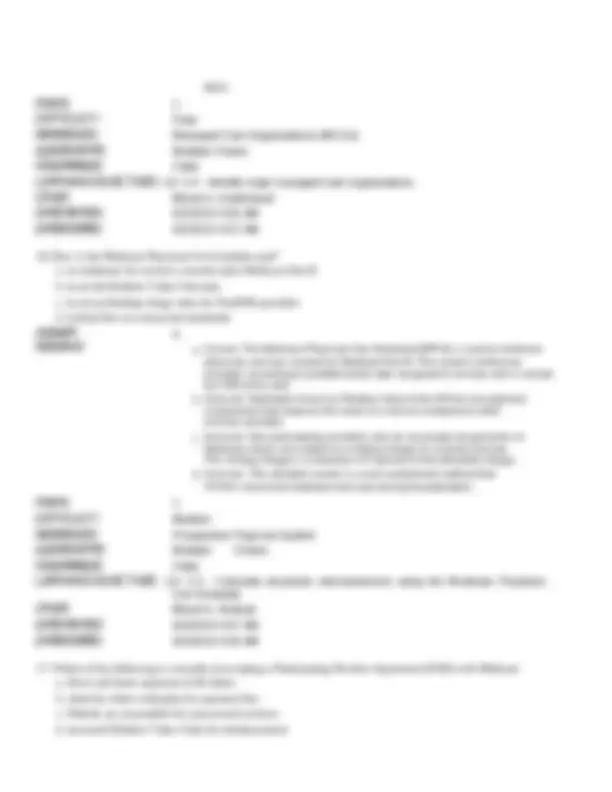
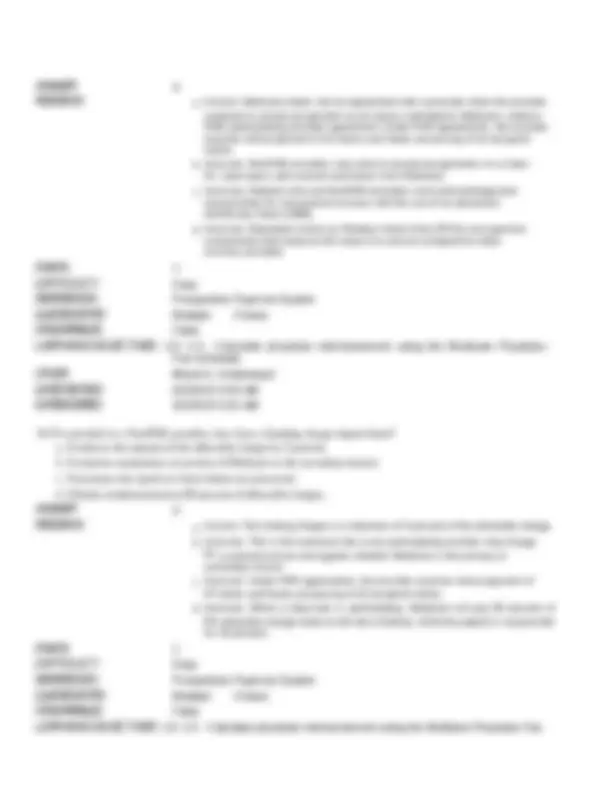
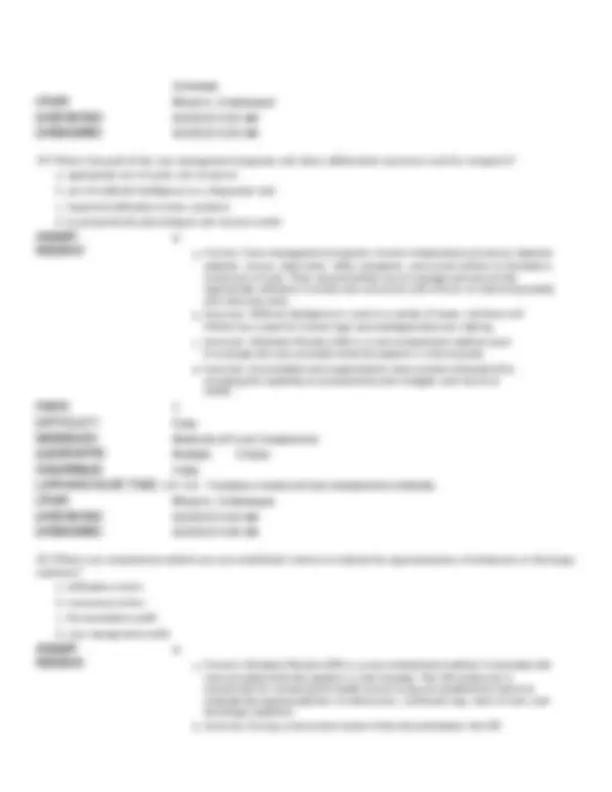

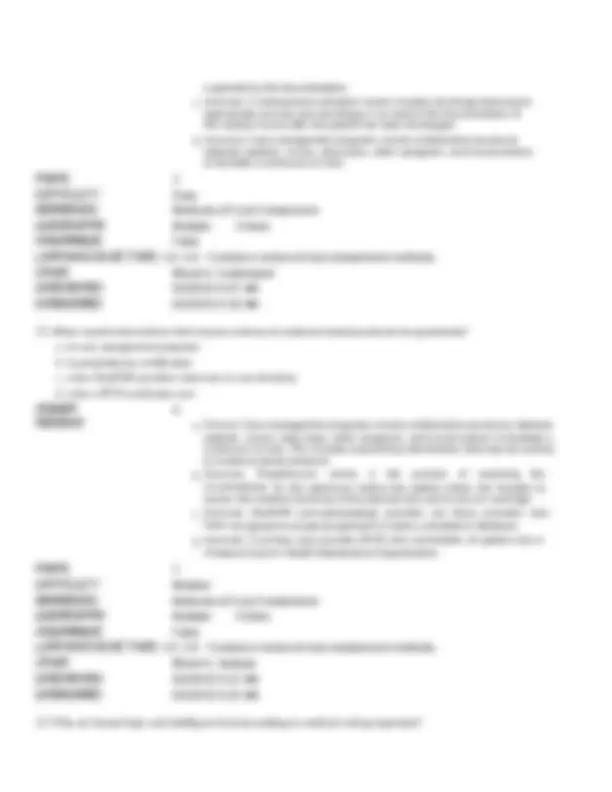
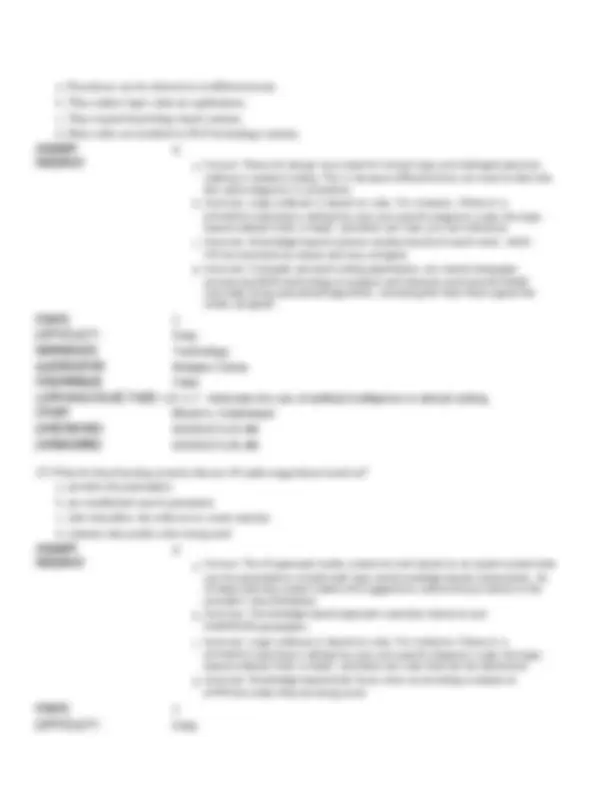
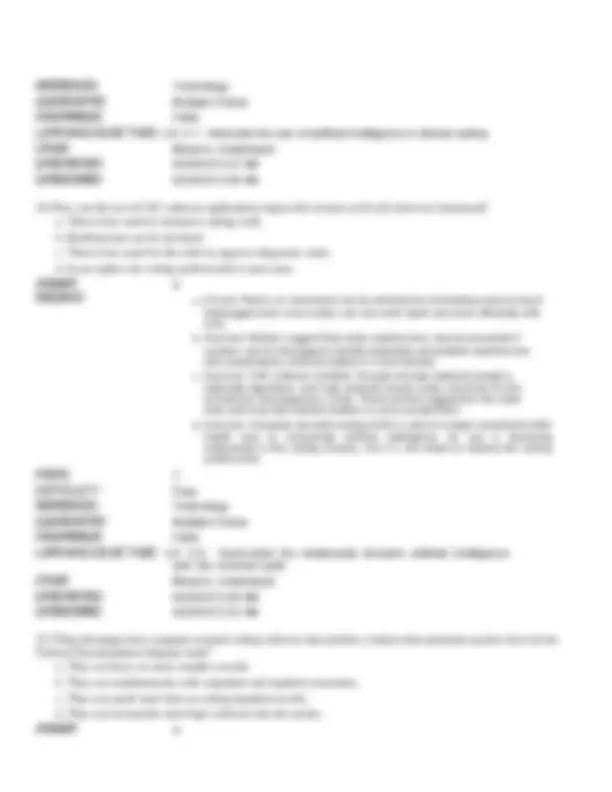
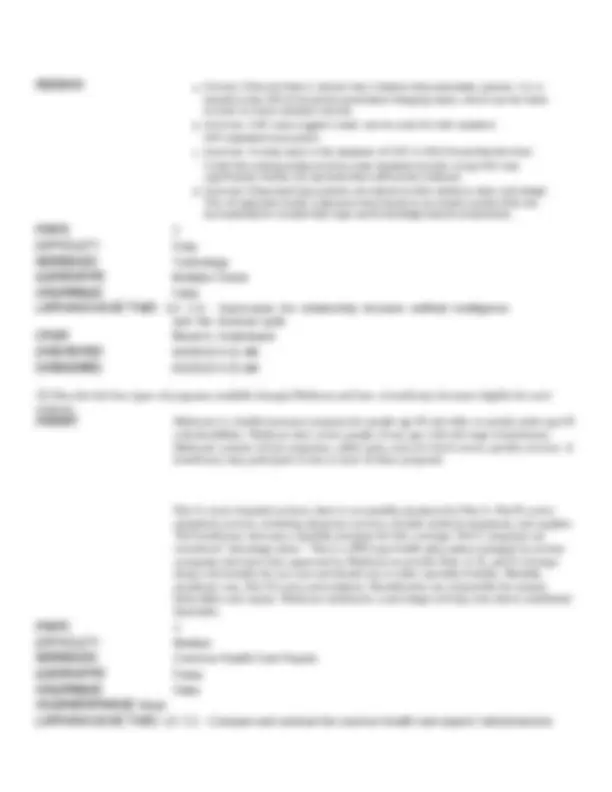
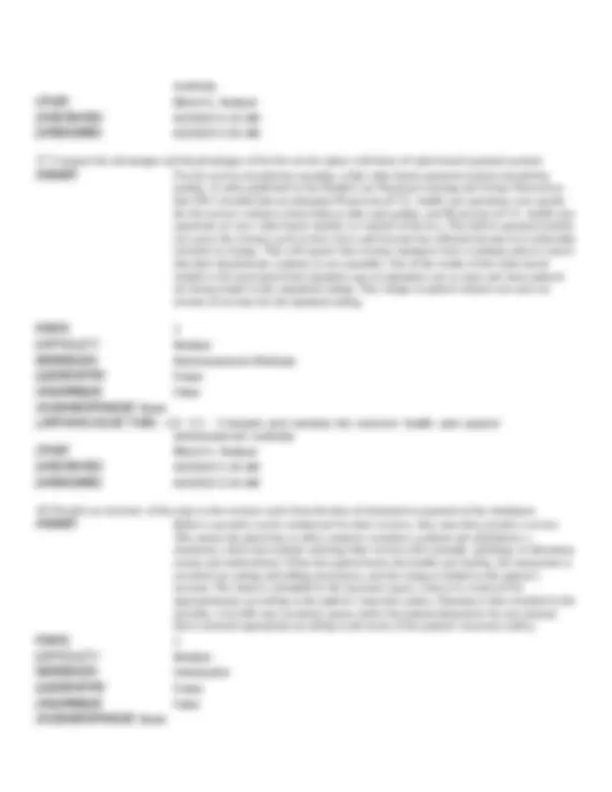
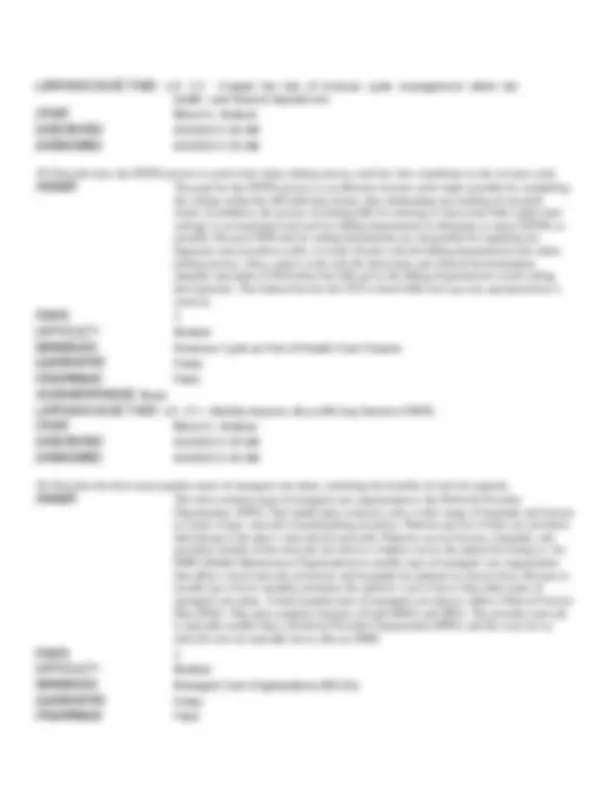

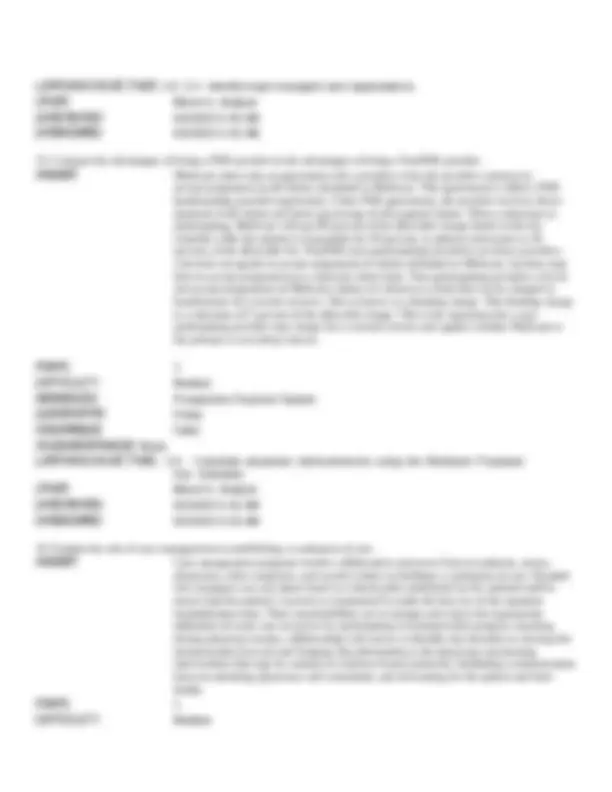
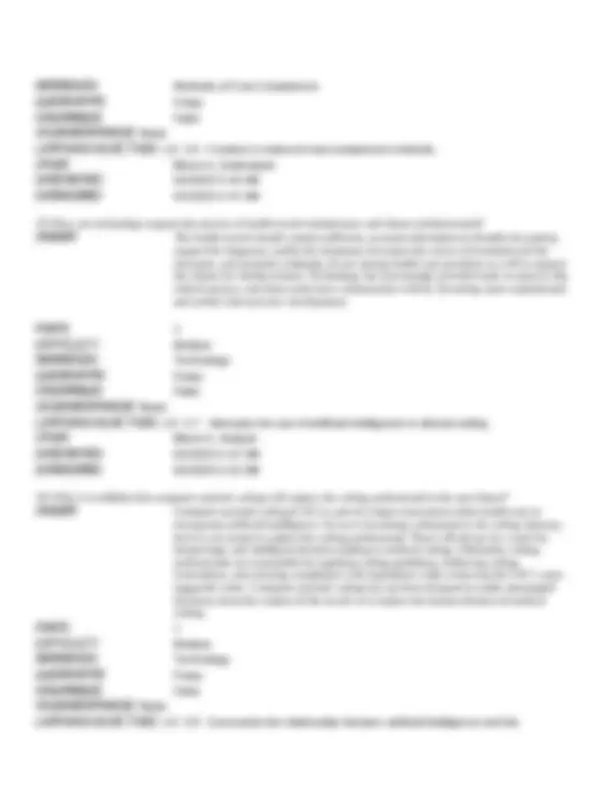
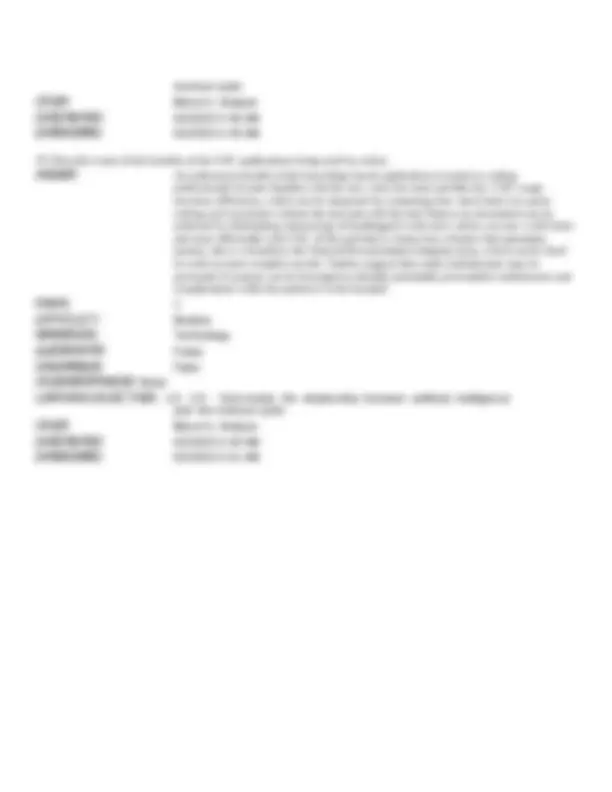
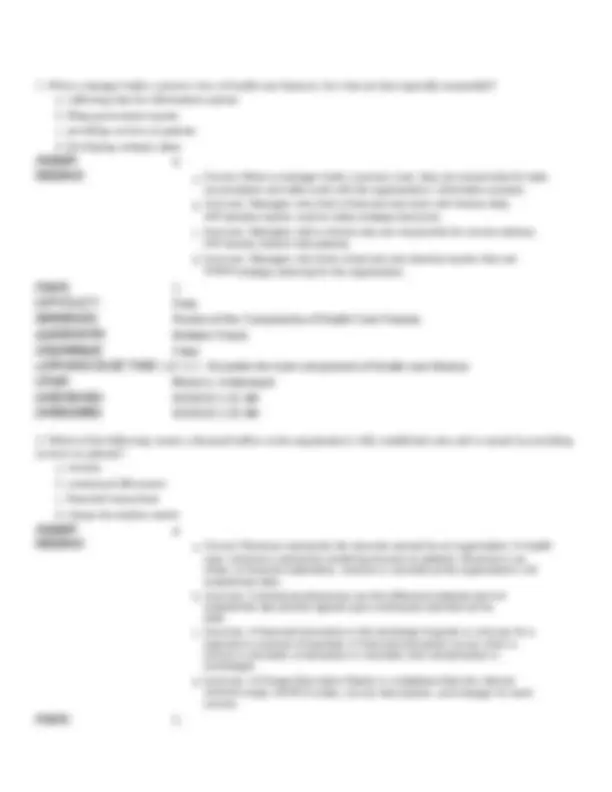

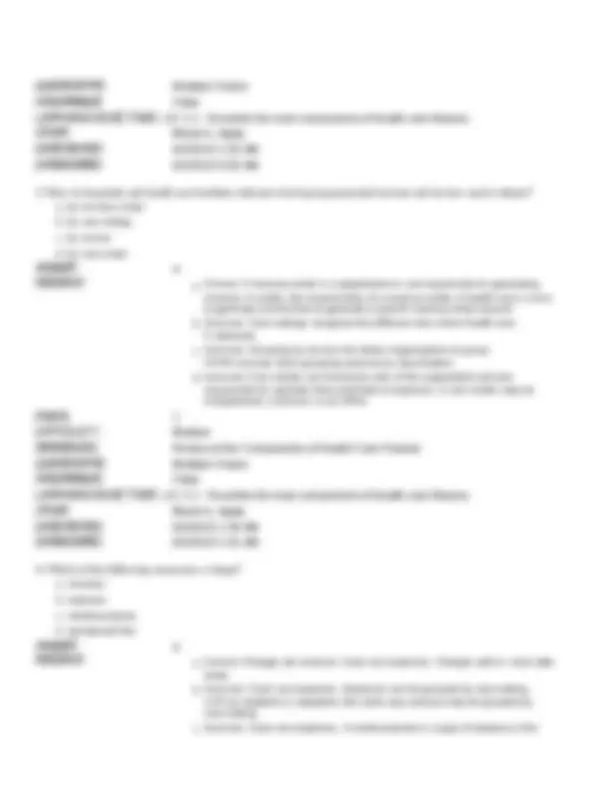
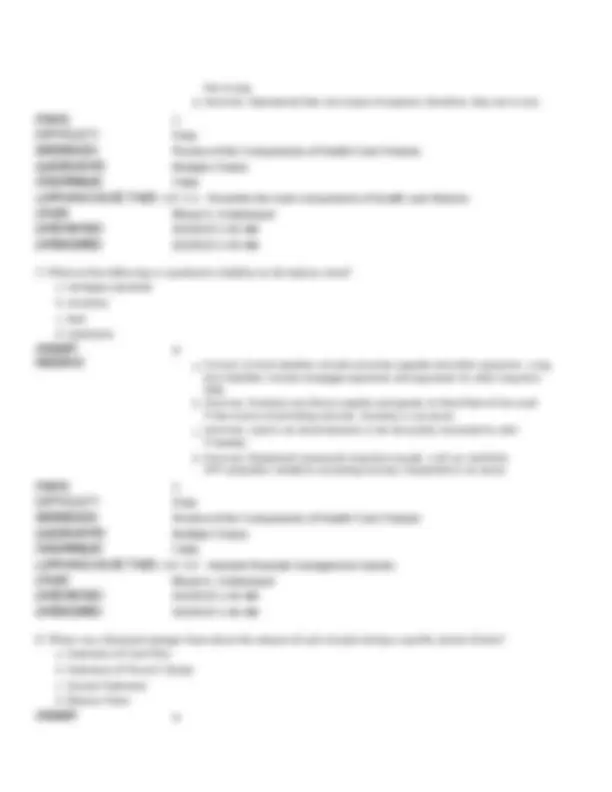
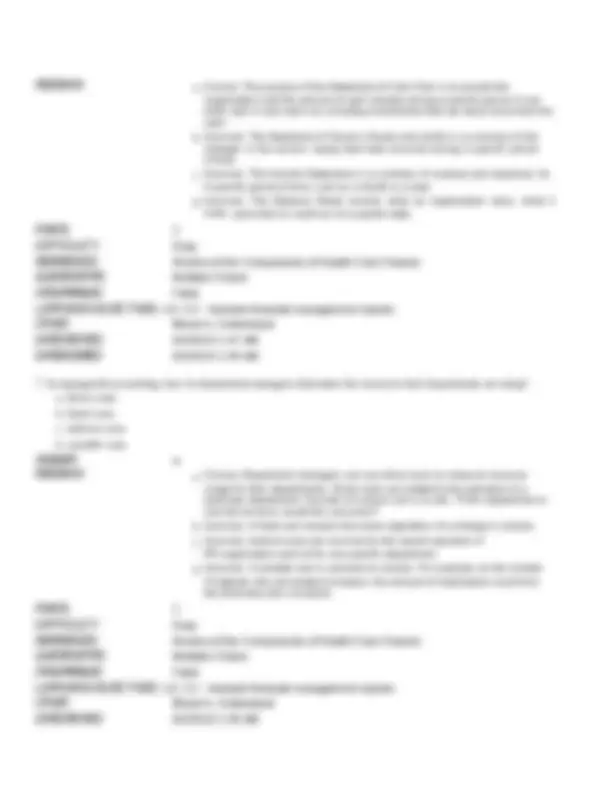

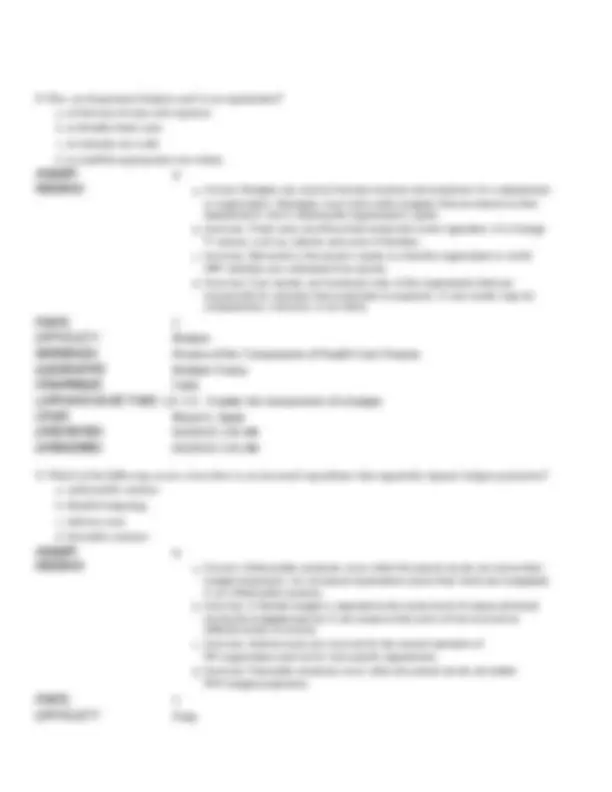

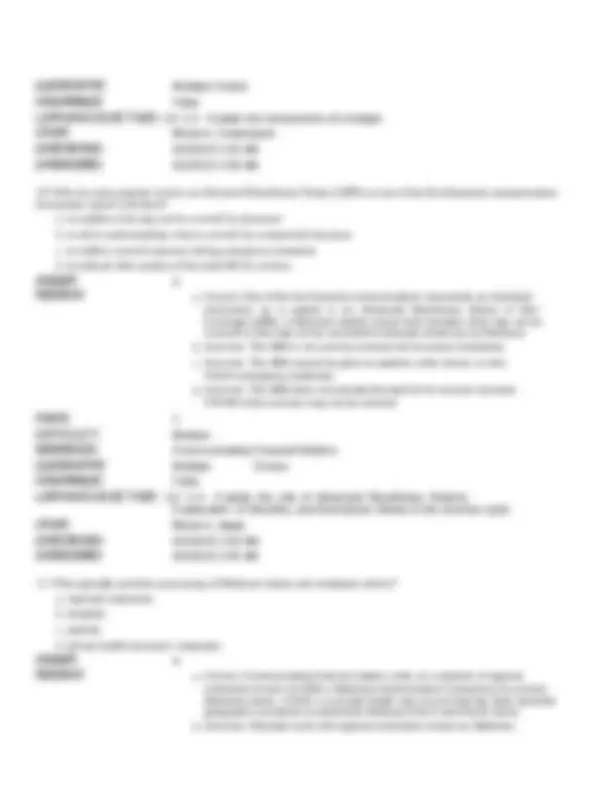
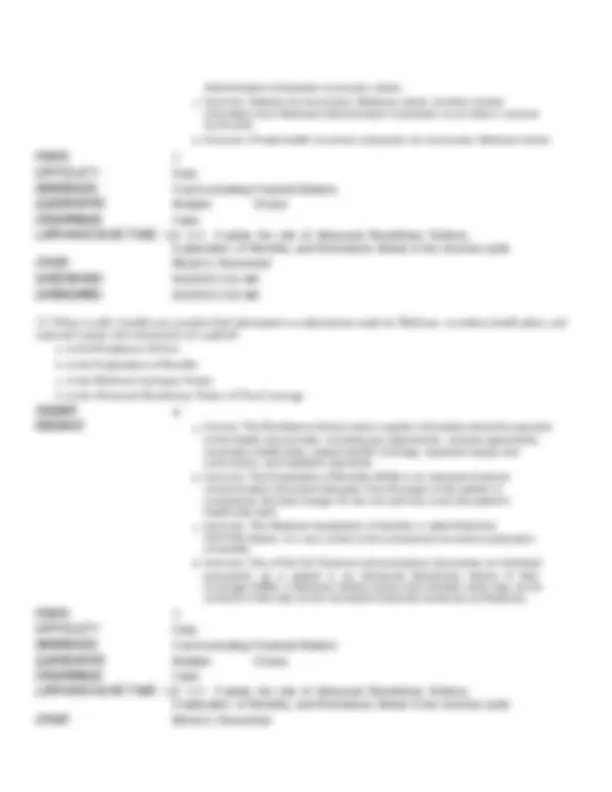

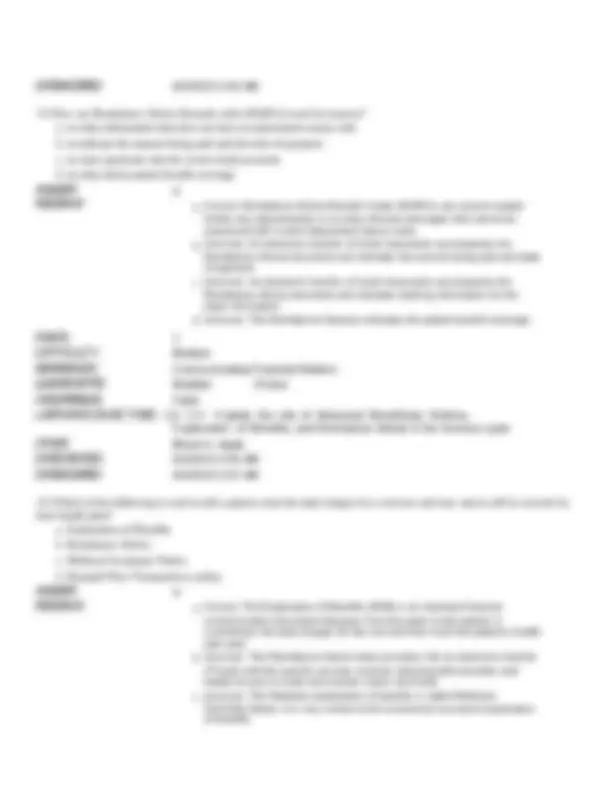

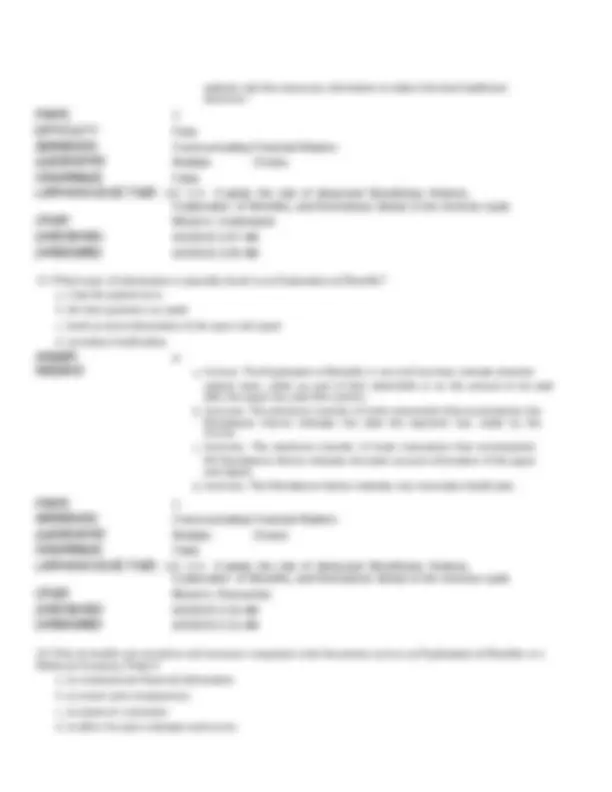

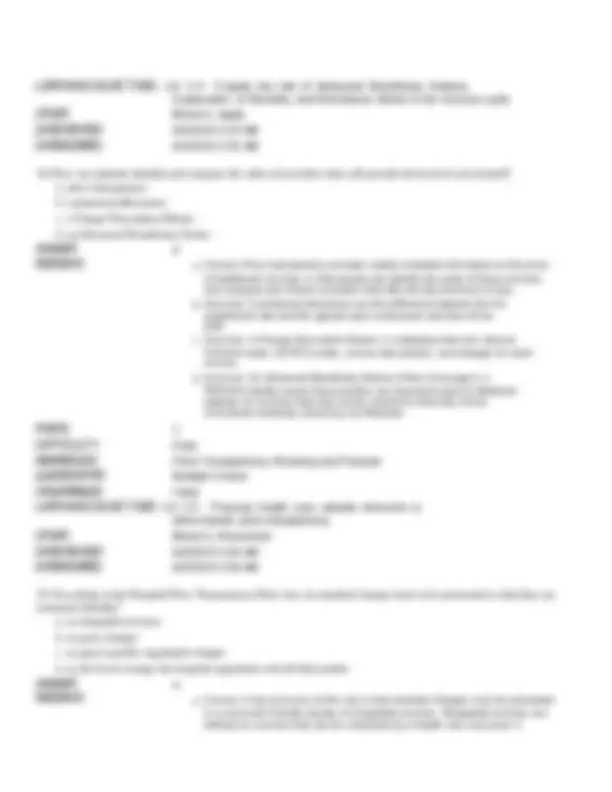

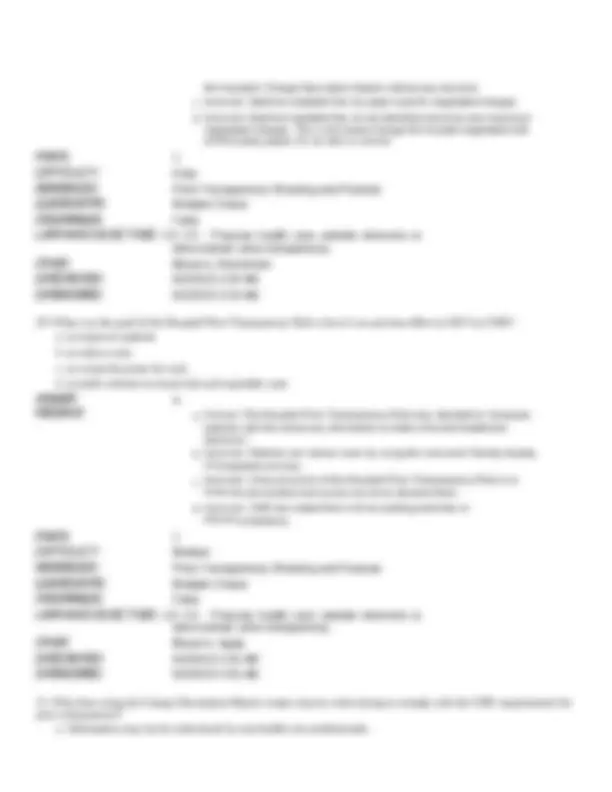
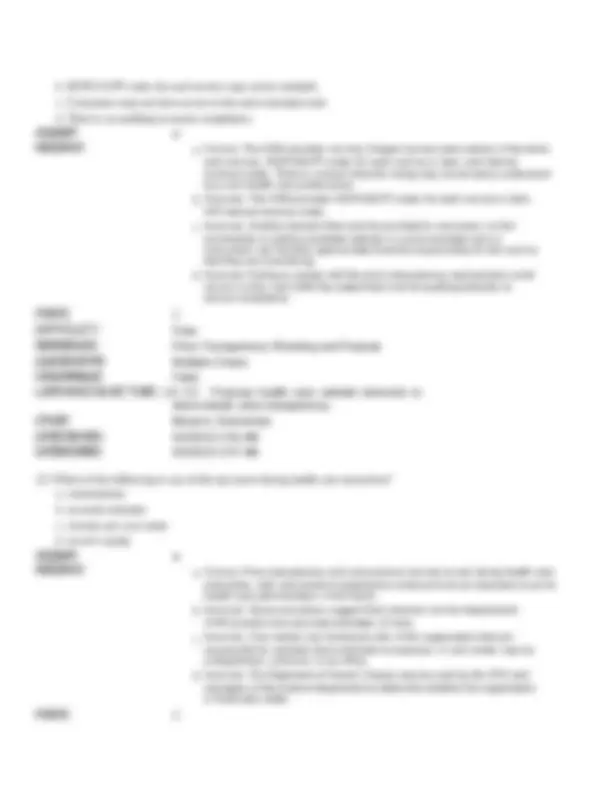

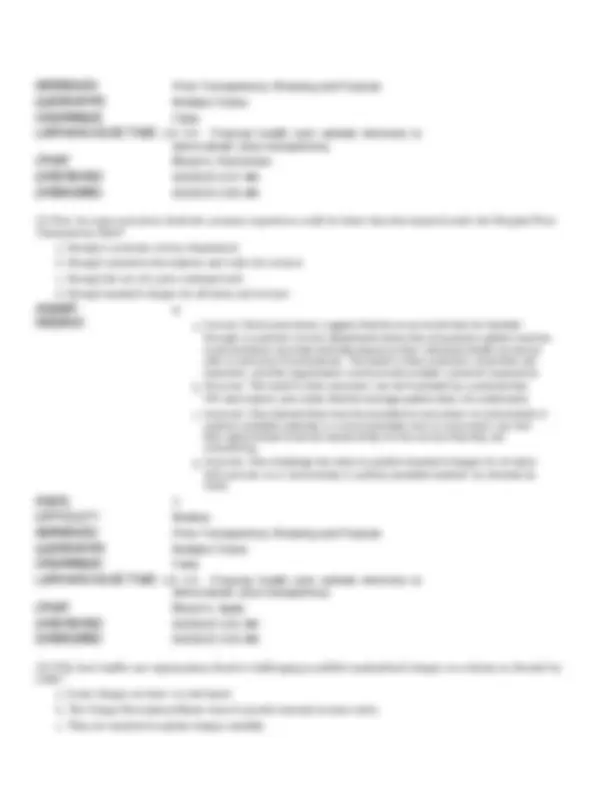

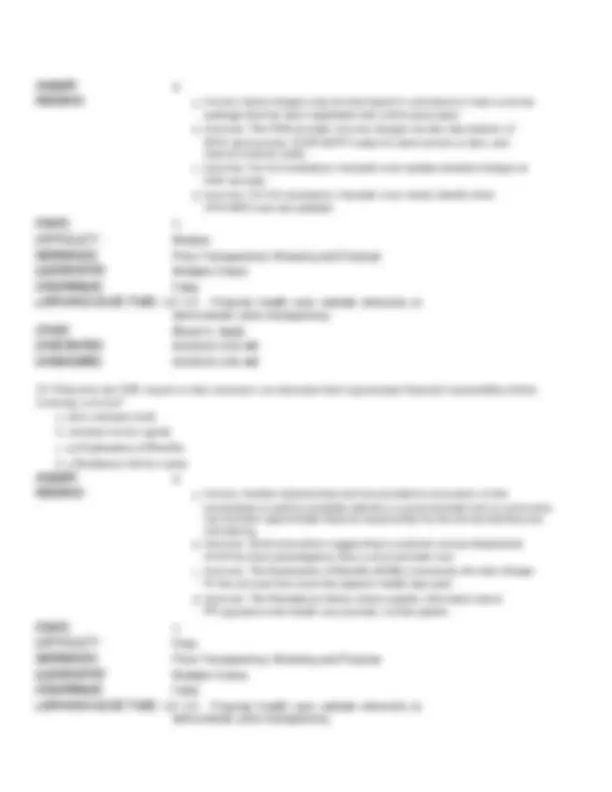

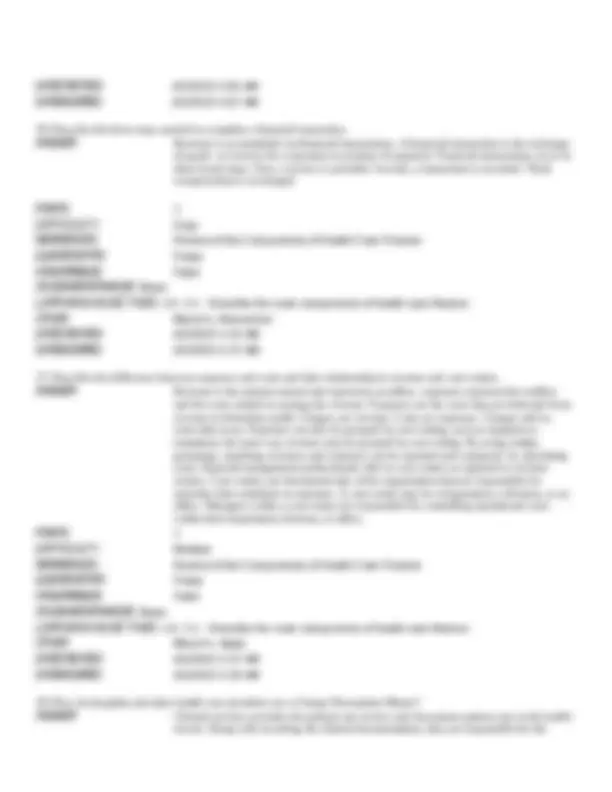
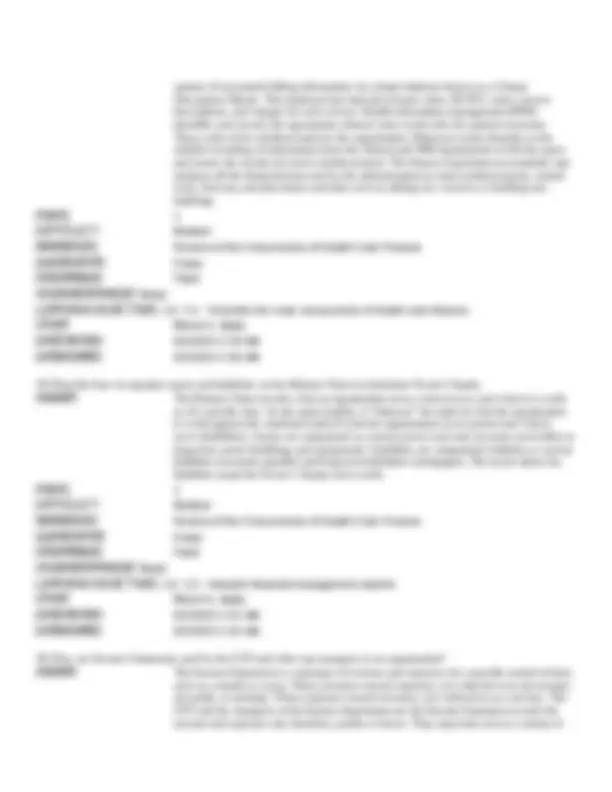
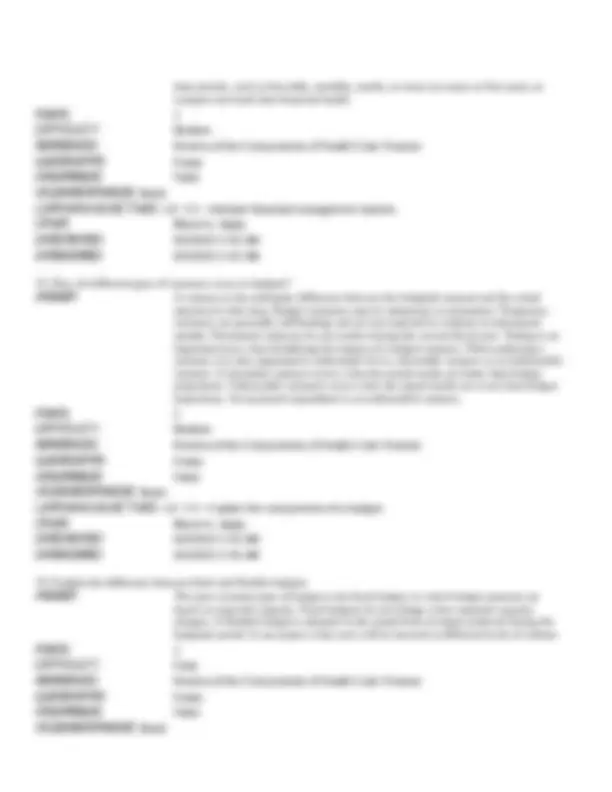
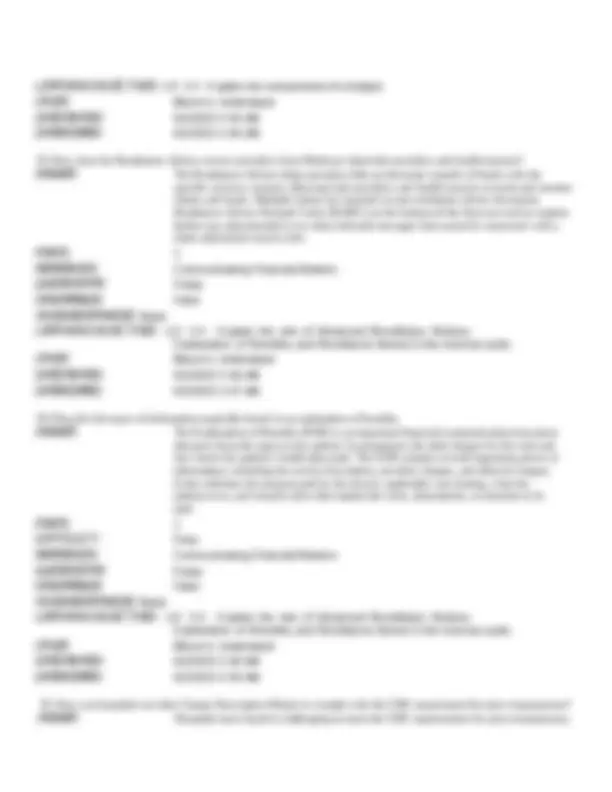

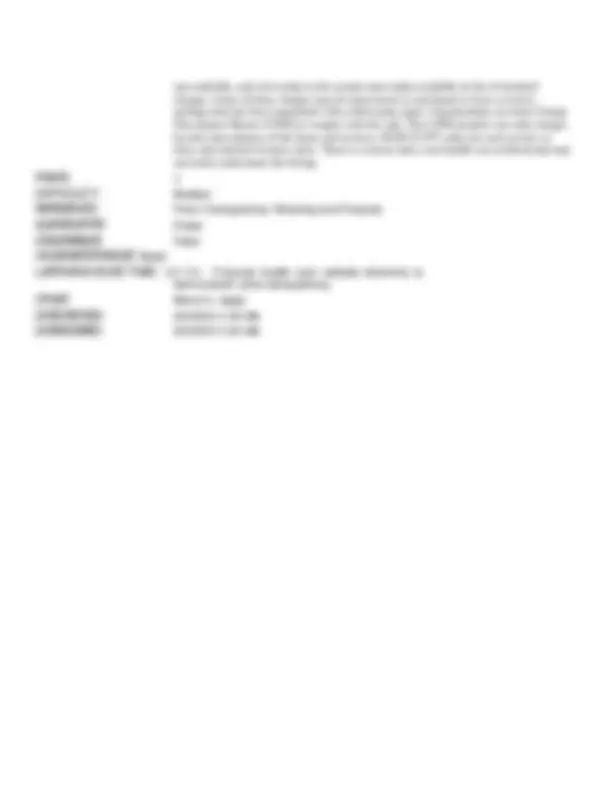
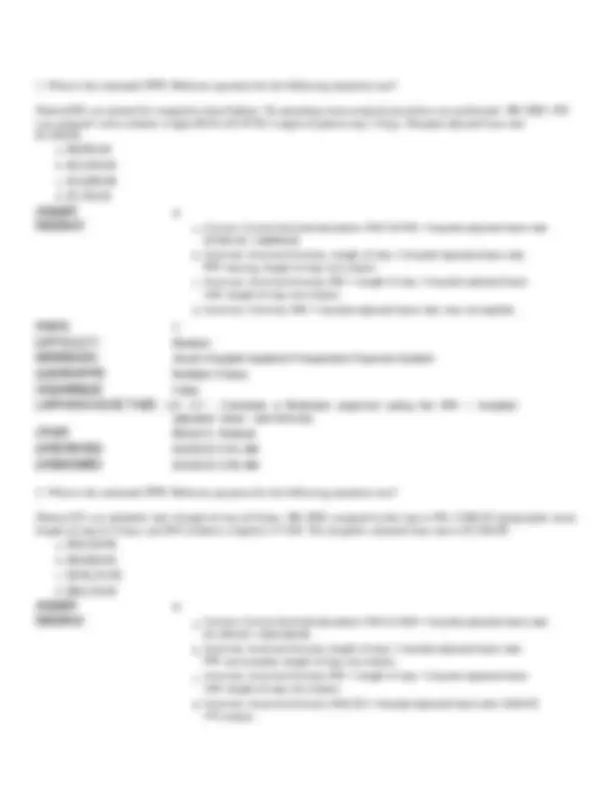

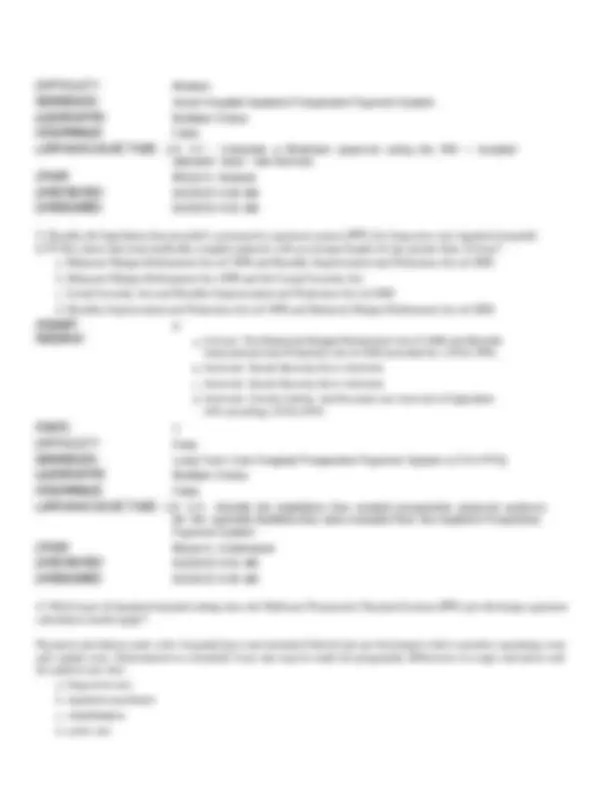
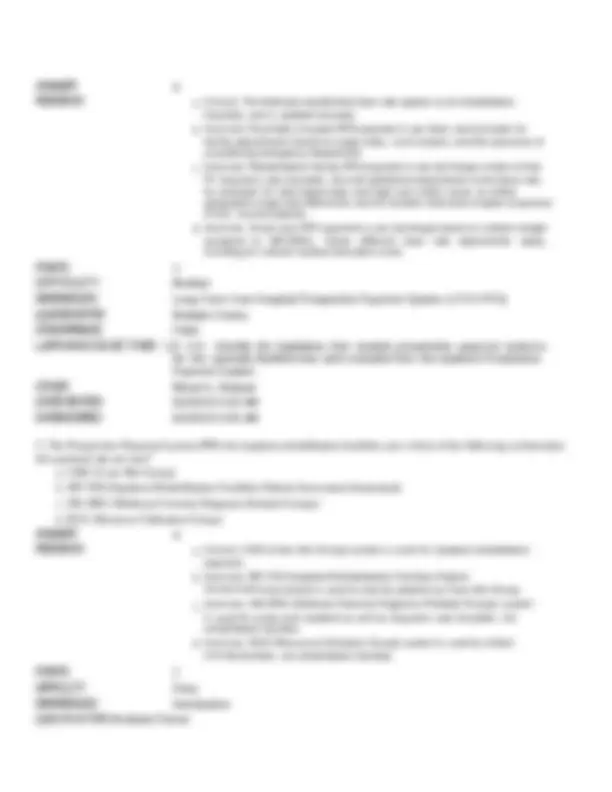
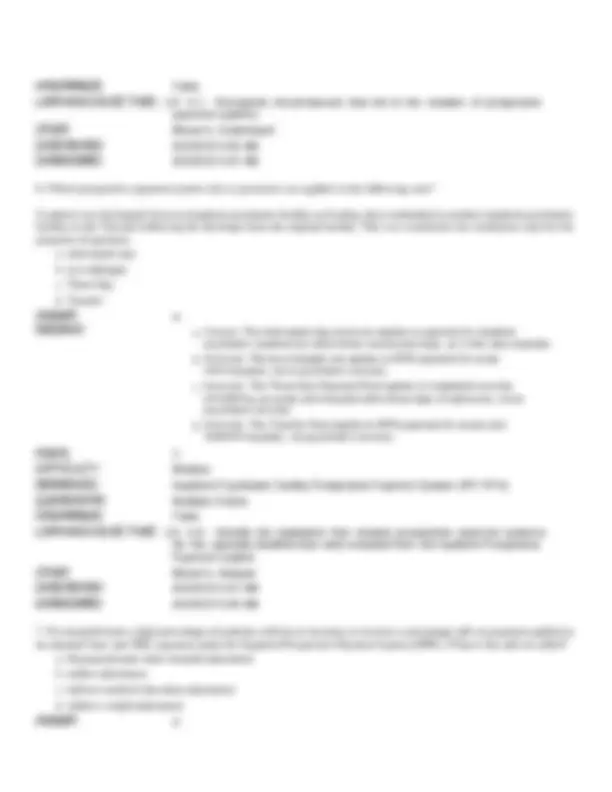
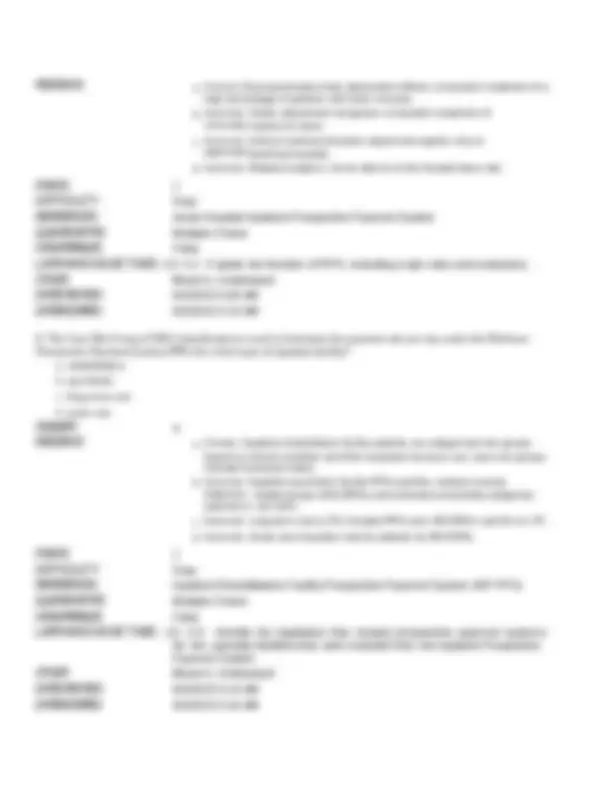

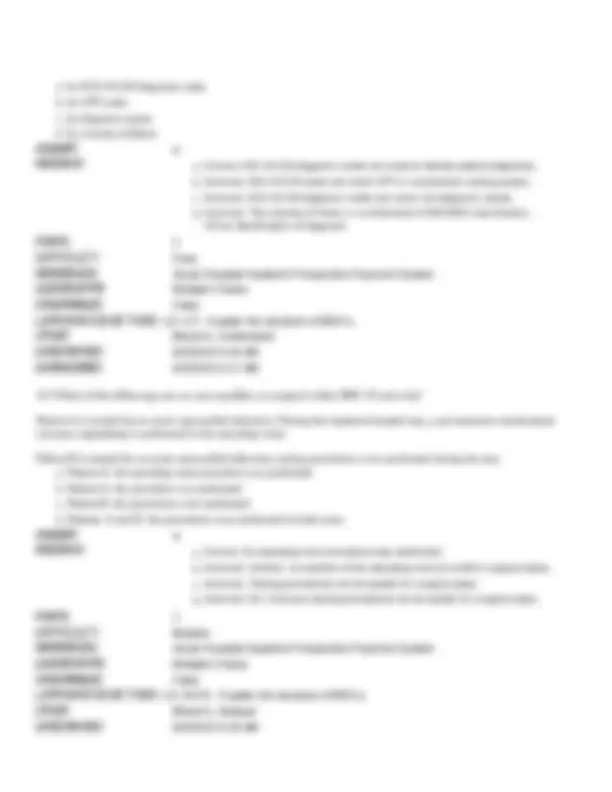
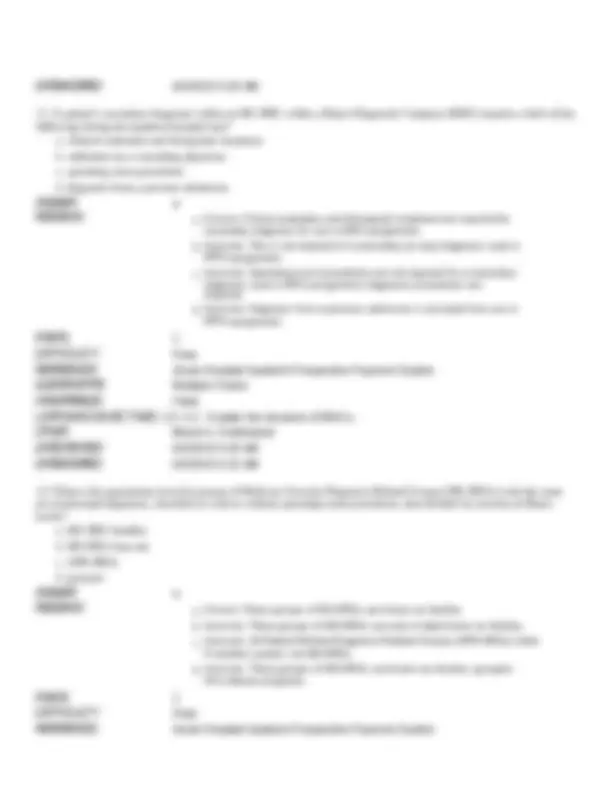

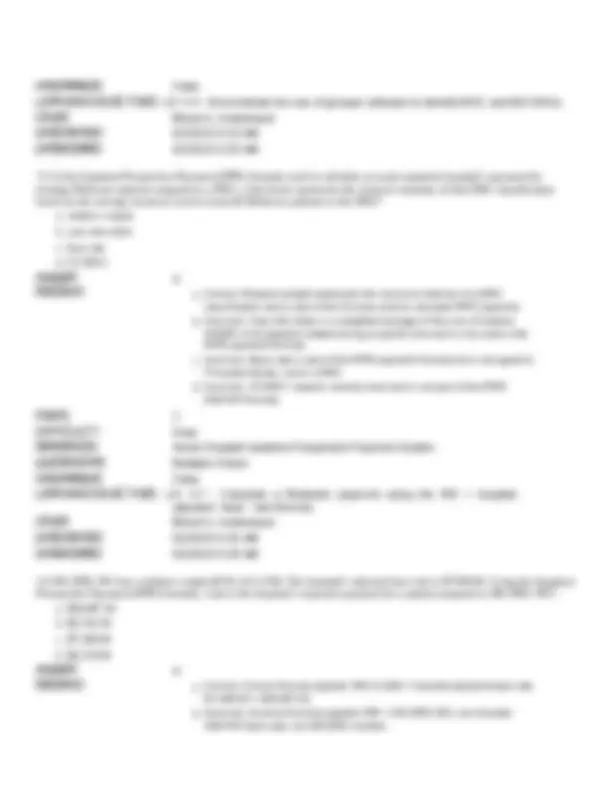
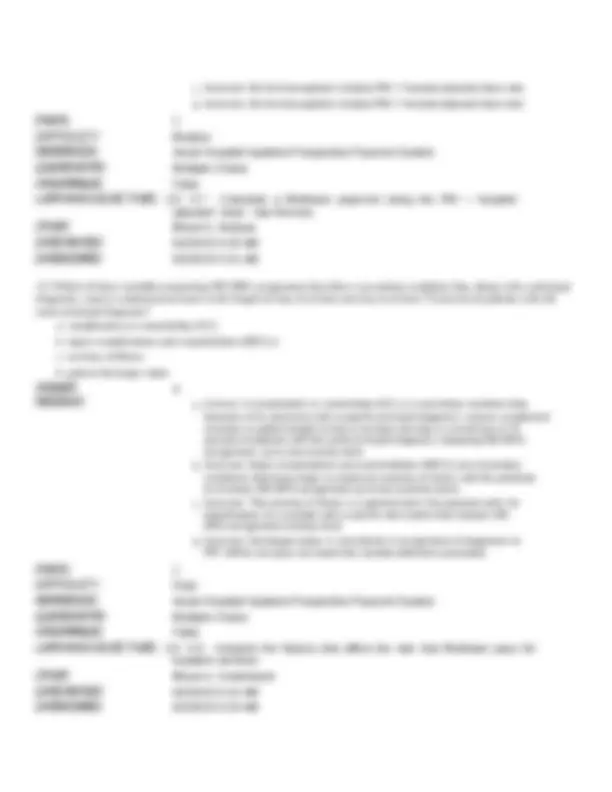
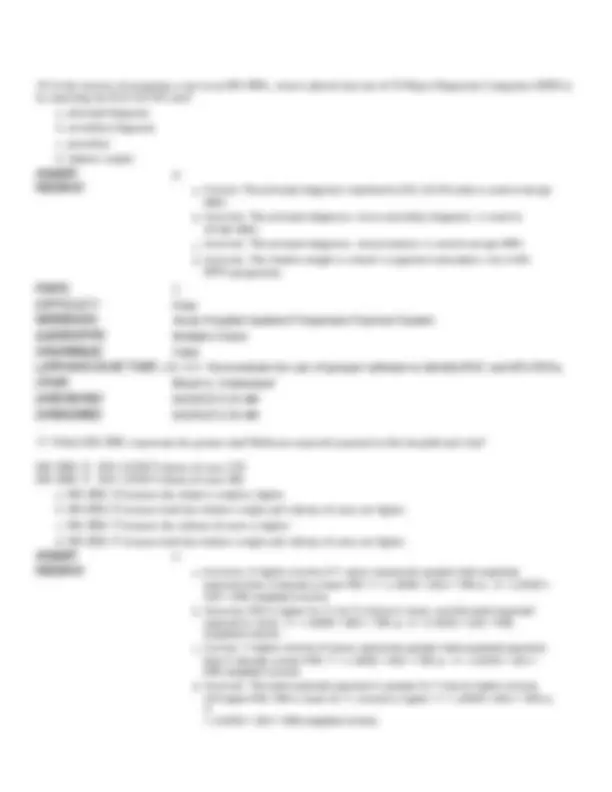



Study with the several resources on Docsity

Earn points by helping other students or get them with a premium plan


Prepare for your exams
Study with the several resources on Docsity

Earn points to download
Earn points by helping other students or get them with a premium plan
Community
Ask the community for help and clear up your study doubts
Discover the best universities in your country according to Docsity users
Free resources
Download our free guides on studying techniques, anxiety management strategies, and thesis advice from Docsity tutors
"Accurate test questions with clear answers to help you ace your exam."
Typology: Exams
1 / 323

This page cannot be seen from the preview
Don't miss anything!





























































































when the patient checks in at the front desk and ends after all payments or denials and appeals have been made. b. Incorrect.^ The^ revenue^ cycle^ ends^ when^ all^ payments^ or^ denials^ and appeals (^) have been made. c. Incorrect.^ Coinsurance^ is^ the^ percentage^ the^ patient^ pays^ for^ covered services (^) after the deductible has been met and the copay has been paid. d. Incorrect.^ Bills^ must^ accurately^ describe^ the^ treatment^ or^ service^ so^ that the (^) claim can be paid appropriately.
maintained to enable health care facilities to deliver quality care to their patients and stay in business. b. Incorrect.^ The^ insurance^ provider,^ not^ the^ provider^ of^ the^ service,^ will ensure (^) that deductibles have been met. c. Incorrect. Health care organizations that are required to comply with HIPAA regulations are known as covered entities (CE), and that definition includes all organizations that electronically transmit any information that is protected under HIPAA. d. Incorrect.^ Medicare^ defines^ abuse^ as^ “practices^ that^ directly^ or^ indirectly result (^) in unnecessary costs to Medicare.”
c. Incorrect. The Privacy Rule covers the use and disclosure of PHI that is transmitted or maintained by electronic media, such as over the Internet to “the cloud” or stored on computer modems or remote servers. d. Incorrect.^ Information^ needed^ to^ prevent^ or^ lessen^ imminent^ danger^ may be (^) disclosed to law enforcement if the information is needed to identify or apprehend an escapee or violent criminal.
and are paid for health care in the normal course of business. b. Incorrect.^ Health^ plans^ are^ individual^ or^ group^ health^ insurance^ plans^ that pay (^) for medical care. c. Incorrect.^ Health^ care^ clearinghouses^ are^ companies^ that^ convert nonstandard (^) transactions into standard transactions and transmit the data to health plans and the reverse process. d. Incorrect. Health care organizations that are required to comply with HIPAA regulations are known as covered entities (CE), and that definition includes all organizations that electronically transmit any information that is protected under HIPAA.
a. the Privacy Rule b. clearinghouses c. revenue cycle management d. the Security Rule
transmitted or maintained by electronic media, such as over the Internet to “the cloud” or stored on computer modems or remote servers. b. Incorrect.^ Health^ care^ clearinghouses^ are^ companies^ that^ convert nonstandard (^) transactions into standard transactions and transmit the data to health plans and the reverse process. c. Incorrect.^ Revenue^ cycle^ management^ consists^ of^ all^ administrative^ and clinical (^) functions that contribute to the capture, management, and collection of patient service revenue. d. Incorrect.^ The^ HIPAA^ Security^ Rule^ protects^ a^ subset^ of^ information^ covered by (^) the Privacy Rule.
right to examine and obtain copies of their records, to direct a covered entity to transmit an electronic copy to a third party, and the right to request corrections. b. Incorrect.^ One^ goal^ of^ the^ Privacy^ Rule^ is^ to^ allow^ the^ flow^ of^ health information (^) needed to provide and promote high-quality health care. c. Incorrect.^ One^ goal^ of^ the^ Privacy^ Rule^ is^ to^ allow^ the^ flow^ of^ health information (^) needed to protect the public's health and well-being. d. Incorrect.^ One^ goal^ of^ the^ Privacy^ Rule^ is^ to^ allow^ the^ flow^ of^ health information (^) needed to provide and promote high-quality health care that protects the public's well-being.
disclosures to other health care providers for treatment purposes must be only the minimum amount of PHI needed to accomplish the intended purpose of the use or disclosure. b. Incorrect.^ Security^ management^ is^ an^ administrative^ safeguard^ used^ to identify (^) and analyze potential risks to ePHI. c. Incorrect.^ Integrity^ controls^ are^ types^ of^ technical^ safeguards^ that^ relate to (^) policies and procedures to ensure the ePHI is not improperly altered or destroyed. d. Incorrect.^ Transmission^ security^ is^ a^ technical^ safeguard^ that^ guards against (^) unauthorized access to ePHI that is being transmitted over an electronic network.
protections, a large portion of the act focuses on preventing fraud and abuse through the Medicare Integrity Program. This program reviews provider claims, cost reports, and payment determinations for fraud and abuse.
b. Incorrect.^ The^ False^ Claims^ Act^ began^ during^ the^ Civil^ War.^ This^ act prohibited (^) federal contractors from knowingly filing a fraudulent claim using false statements or otherwise conspiring to defraud the U.S. government. c. Incorrect.^ The^ False^ Claims^ Act^ formed^ the^ foundation for^ more^ recent^ laws, like the Medicare and Medicaid Patient and Program Protection Act of
d. Incorrect.^ In^ 1995,^ Operation^ Restore^ Trust^ targeted^ fraud^ and^ abuse among (^) health care providers.
unnecessary costs to Medicare.” These include practices that are not medically necessary services or that do not meet professionally recognized standards of care. b. Incorrect. Fraud includes knowingly billing for services at a level of complexity higher than the services actually provided or documented in the medical record. c. Incorrect.^ Fraud^ includes^ billing^ Medicare^ for^ appointments^ patients^ did not (^) keep. d. Incorrect.^ Fraud^ includes^ knowingly^ ordering^ medically^ unnecessary^ items of (^) service for a patient.
a. capitation b. fee schedule c. clean claim d. Charge Description Master
time paid in advance to the physician for the delivery of health care services for patients/beneficiaries in a health care plan. The provider agrees to accept, in full, the payment established in the contract. b. Incorrect.^ A^ fee^ schedule^ is^ a^ predetermined^ list^ of^ fees^ that^ the^ payer allows (^) for the payment of all health care services. c. Incorrect.^ All^ providers^ strive^ to^ submit^ a^ clean^ claim—one^ that^ is correctly (^) completed without errors or omissions. d. Incorrect.^ The^ Charge^ Description^ Master^ is^ a^ database^ that^ contains^ all the (^) information necessary for the system to place the information on the claim form.
information up front starts with patient scheduling and registration. Successful health care revenue cycle management strategies focus on front-end tasks. b. Incorrect. Accurate code assignment by the HIM coding staff and having an updated Charge Description Master, which is a database that contains all the information necessary for the system to place the information on the claim form, leads to the submission of more clean claims. c. Incorrect. Claims adjudication is used to verify that the patient on the claim is covered by their company’s policy, the services are necessary, and the patient will benefit from them. They also verify the policy’s deductibles, copays, and coinsurance. d. Incorrect. Inthe middle ofthe revenue cycle, the patient isseen bythe health care provider. The visit is documented , including all physical examinations or treatmentsthatareprovided.
health plan benefits to verify that all required information is available to process the claim, that the claim is not a duplicate submission, and that the procedures performed or services provided are covered benefits. b. Incorrect. A clean claim is one that is correctly completed without errors or omissions. This means accurate code assignment by the HIM coding staff and having an updated Charge Description Master. c. Incorrect.^ Before^ the^ claim^ is^ adjudicated,^ all^ the^ required^ data^ is^ posted^ to the (^) claims and the claims are in a computer file, which are then transmitted electronically to a clearinghouse. d. Incorrect.^ Pre-certification^ or^ authorization^ assesses^ medical^ necessity^ and is (^) done before patient check-in.
provided is an important focus of compliance with regulations. This is where HIM professionals play an important role. b. Incorrect. The evolution of health care reimbursement that brought us to this place in history began in the 1930s in Texas at Baylor University, and continues to be amended by the government. c. Incorrect.^ Medicare^ applies^ only^ to^ older^ adults^ or^ people^ with^ lower^ incomes. d. Incorrect.^ Revenue^ cycle^ management^ consists^ of^ all^ administrative^ and clinical (^) functions that contribute to the capture, management, and collection of patient service revenue.
payer paid the claim. It also lists the plan deductible that the patient has met and what their out-of-pocket expenses are. b. Incorrect.^ The^ insurance^ companies^ assure^ their^ members^ quality^ care^ at lower (^) costs by providing lists of providers who have negotiated to provide health care to their members under their insurance plan. c. Incorrect. HIM professionals use diagnoses and procedures codes for inpatients and outpatients based on the clinical documentation and according to all official guidelines. d. Incorrect. After data has been posted to the claims, claims are sent to a clearinghouse, where data is mapped into a transaction format. The clearinghouses electronically transmit the claims to the payer’s clearinghouse.
and technology within a multidisciplinary team composed of clinical, admissions, health information management, clinical documentation integrity, and billing departments. b. Incorrect. HIPAA stipulates how personally identifiable protected health information (PHI) is maintained by health care providers, health plans, and health care clearinghouses, including how it should be protected. c. Incorrect.^ The^ privacy^ rule^ stipulated^ under^ HIPAA^ strives^ to^ protect information (^) and provides rights to individuals over their personal information. d. Incorrect.^ HIPAA^ has^ specific^ requirements^ for^ security^ of^ information shared (^) over the cloud, as do Medicare and Medicaid.
maintains, or transmits in electronic form is referred to as ePHI.
b. Incorrect.^ Security^ management^ is^ an^ administrative^ safeguard^ that identifies (^) and analyzes potential risks to ePHI. c. Incorrect.^ Operation^ Restore^ Trust^ targeted^ fraud^ and^ abuse^ among^ health care (^) providers in a joint effort between HHS (Department of Health and Human Services), OIG (Office of Inspector General), CMS (Centers for Medicare and Medicaid Services), and the Administration on Aging. d. Incorrect.^ A Charge Description Master is a database that contains all the information necessary for the system to place the information on the claim form.
workstation and device security. Policies and procedures should include the transfer, removal, disposal, and re-use of electronic media. b. Incorrect.^ Information^ access^ management^ is^ an^ administrative^ safeguard. c. Incorrect.^ Integrity^ controls,^ including^ policies^ and^ procedures^ to^ ensure that (^) ePHI is not improperly altered or destroyed, fall under technical safeguards. d. Incorrect.^ Workforce^ training^ and^ management,^ as^ administrative safeguards, (^) include training, policies and procedures, and sanctions against employees who violate policies and procedures.
provide a common reference point for comparisons and collection of data about the entire health care process, recorded by multiple different individuals, systems, or health care organizations. b. Incorrect. Clinical classification systems are intended for the classification of clinical conditions and procedures in support of statistical data analysis, but they are widely used for reimbursement, public health reporting, quality of care assessment, education, research, and monitoring the performance of providers. c. Incorrect. Robotic process automation helps to reduce costs and fill the gaps across the revenue cycle by engaging patients digitally to pre-register, providing self-service options that patients can initiate at their convenience, and prompting patients for additional information when data is missing or questions arise. d. Incorrect.^ Predictive^ analytics^ is^ a^ type of^ machine^ learning^ that^ can^ be^ used to (^) forecast revenue, allowing the health care administration to correct issues that impact revenue before they occur.